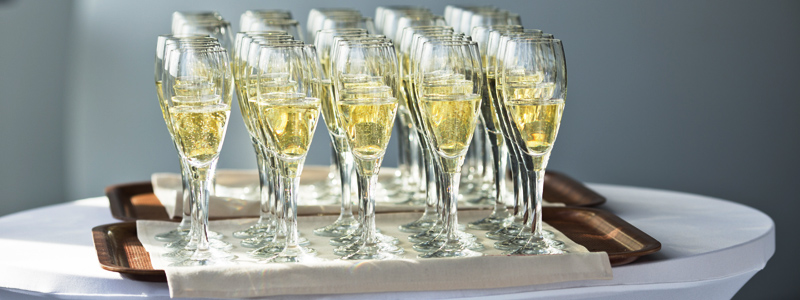We’ve all tasted sparkling wine, at the very least around the holidays or when celebrating a special occasion, yet many of us have no idea what the difference is between wines such as Champagne, Cava and Prosecco—or how they even get the bubbles into the wine in the first place. Let us explain.
There are many legends of how sparkling wine came to be created, but the myth we like best is the story of Monk Dom Perignon.
Sparkling wine is a carbonated wine, a wine that has bubbles, which usually takes on the name associated with the region or country specific to where the wine originated. The carbonation in sparkling wine is created using one of two methods: Méthode Champenoise (Champagne method) or Metodo Italiano, which is also known as the Charmat-Martinotti method.
There are many legends of how sparkling wine came to be created, but the myth we like best is the story of Monk Dom Perignon. As the story goes, in the 1600s the monk was making white wine in the Champagne region of France. He decided to bottle the wine he had fermented earlier than usual because, when he checked the fermentation tanks, it seemed to him that the yeast had finished converting all the sugar to alcohol. In fact, the temperature in the Champagne region had become so cold that the yeast in the tanks had simply gone to sleep, even though they weren’t done eating all the sugar. When the spring came and the wine in the bottles began to warm, the yeast woke up and hurriedly began eating all of the leftover sugar. As they ate the sugar, the carbon dioxide they were creating had no place to escape, as it would in a large fermentation tanks, so instead the CO2 was absorbed by the wine, thereby carbonating it. When Dom Perignon went to check on his wine he encountered corks popping all around him; he tasted the wine and loved the results, thus the birth of Champagne. Since the discovery of the Champagne method, which is often called the traditional method, Champagne has exploded across the world, quickly becoming the most well-known and highly regarded sparkler.
While the story of Dom Perignon is a myth, and we’re pretty sure it isn’t true, it is an excellent way to explain the Champagne method. Using this method, Perignon “discovered” that a secondary fermentation in the bottle could be used to create the bubbles we associate with a sparkling wine.
Since the discovery of the Champagne method, which is often called the traditional method, Champagne has exploded across the world, quickly becoming the most well-known and highly regarded sparkler. It is for this reason that most other wine regions adopted the method as the way to make sparkling wine, including Spanish Cava. So if the majority of sparkling wine is made using the Champagne method, why don’t we call all sparkling wine Champagne?
As you might expect, the French are pretty territorial over the name, allowing only sparkling wine that is actually made in the Champagne region of France to be called Champagne. Just as Kleenex wouldn’t like it if a rival brand referred to their tissue as a Kleenex, the French hate it when wine that is not from Champagne is called Champagne. This why we had the creation of the name Cava to refer to sparkling wines from Spain. For a long time the Spanish referred to their products as Champagne, knowing that consumers’ familiarity with the name as a quality sparkling wine would benefit their sales, but the French cried foul, and lobbied the EU to forbid any other country from using the name Champagne unless it comes from that region in France.
Sparkling wine has four levels of sweetness. The level of sweetness of the wine will be printed directly on the bottle. These levels are:
While it’s the best known method for making sparkling wine, the Champagne method takes time and can be very expensive, as you have to allow the wine time to ferment in the tank and then again in each individual bottle for a minimum of fifteen months. Looking for a faster and cheaper way to create quality sparkling wine, Frenchman Eugene Charmat and, separately in Italy, Federico Martinotti discovered what is now known as the Charmat-Martinotti method. In this method, the wine is transferred from its first fermentation vat to a large sealed pressurized tank where it undergoes secondary fermentation to create the carbonation. Then the carbonated wine is bottled and shipped to market. This is how all Italian Prosecco is made.
The real difference between the Charmat-Martinotti method and the Champagne method is the ultimate taste of the wine. Wines in the Charmat-Martinotti method tend to be younger and fruitier while wines made using the Champagne method are often drier and less fruity.
Keep Reading About Sparkling Wines
- The Quick And Dirty Guide To Sparkling Wines From Around The World
- How To Make Sparkling Wines Like Champagne [INFOGRAPHIC]
- Our Reader Panel Names The Best Sparkling Wines To Buy Now
- Pairing a $3.99 Box of Popeyes with $170 Dom Perignon
- The Sparkling Wine Cocktails Everyone Should Know How To Make
- Legends & Myth: The History Of Champagne Sabering
